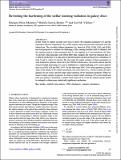Por favor, use este identificador para citar o enlazar a este item:
http://hdl.handle.net/10261/189162COMPARTIR / EXPORTAR:
 SHARE SHARE
 CORE
BASE CORE
BASE
|
|
| Visualizar otros formatos: MARC | Dublin Core | RDF | ORE | MODS | METS | DIDL | DATACITE | |

| Título: | Revisiting the hardening of the stellar ionizing radiation in galaxy discs |
Autor: | Pérez Montero, Enrique ; García-Benito, Rubén CSIC ORCID ; Vílchez Medina, José Manuel CSIC ORCID | Palabras clave: | ISM: abundances Galaxies: abundances Methods: data analysis |
Fecha de publicación: | 2019 | Editor: | Oxford University Press | Citación: | Monthly Notices of the Royal Astronomical Society 483: 3322- 3335 (2019) | Resumen: | In this work we explore accurate new ways to derive the ionization parameter (U) and the equivalent effective temperature (T∗) in H II regions using emission-line intensities from the ionized gas. The so-called softness parameter (η), based on [O II], [O III], [S II], and [S III], has been proposed to estimate the hardening of the ionizing incident field of radiation, but the simplest relation of this parameter with T∗ also depends on U and metallicity (Z). Here we provide a Bayesian-like code (HCM-TEFF) that compares the observed emission lines of η with the predictions of a large grid of photoionization models giving precise estimations of both U and T∗ when Z is known. We also study the radial variation of these parameters in well-studied disc galaxies observed by the CHAOS collaboration. Our results indicate that the observed radial decreasing of η can be attributed to a radial hardening of T∗ across galactic discs as in NGC 628 and NGC 5457. On the other hand NGC 5194, which presents a positive slope of the fitting of the softness parameter, has a flat slope in T∗. On the contrary the three galaxies do not seem to present large radial variations of the ionization parameter. When we inspect a larger sample of galaxies, we observe steeper radial variations of T∗ in less bright and later-type galaxies, mimicking a similar trend observed for Z, but the studied sample should be enlarged to obtain more statistically significant conclusions. © 2018 The Author(s). | Versión del editor: | http://dx.doi.org/10.1093/mnras/sty3330 | URI: | http://hdl.handle.net/10261/189162 | DOI: | 10.1093/mnras/sty3330 | Identificadores: | doi: 10.1093/mnras/sty3330 issn: 1365-2966 |
| Aparece en las colecciones: | (IAA) Artículos |
Ficheros en este ítem:
| Fichero | Descripción | Tamaño | Formato | |
|---|---|---|---|---|
| IAA_2019_sty3330.pdf | 4,8 MB | Adobe PDF |  Visualizar/Abrir |
CORE Recommender
SCOPUSTM
Citations
9
checked on 12-abr-2024
WEB OF SCIENCETM
Citations
5
checked on 22-feb-2024
Page view(s)
169
checked on 19-abr-2024
Download(s)
121
checked on 19-abr-2024
Google ScholarTM
Check
Altmetric
Altmetric
NOTA: Los ítems de Digital.CSIC están protegidos por copyright, con todos los derechos reservados, a menos que se indique lo contrario.
